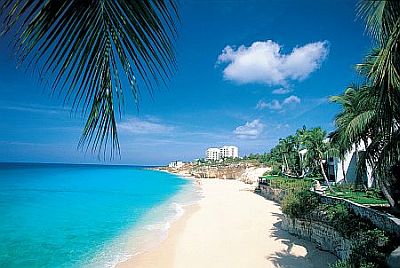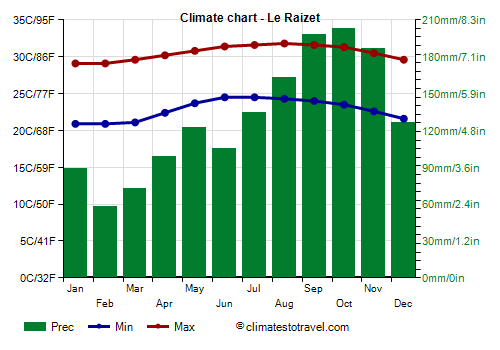Select units of measurement for the temperature and rainfall tables (metric or imperial).
Average weather, temperature, rainfall, sunshine
In Guadeloupe, the climate is tropical,
hot and humid all year round, with a relatively cool and dry season from January to mid-April, called
carême (Lent), and a hot, humid and rainy season from mid-June to mid-November, called
hivernage (the root of the word reminds of the winter, although it is a hot season, and also quite sunny).
In the former period, the
northeast trade winds, constant winds typical of tropical climates, blow steadily and with moderate intensity, while in the latter period, these winds are more irregular, and may have some breaks, increasing the feeling of sultriness. Between them, there are two
transitional periods: from mid November to early January (when the northeast trade winds start to blow, the temperature decreases a bit and the weather gets better) and from mid-April to Mid-June (when both the temperature and the frequency of downpours gradually increase).
Guadeloupe, an
overseas region of France, is an island located in the Caribbean at 16 degrees north latitude. It is actually formed by two islands connected together: Basse-Terre (the western island, where the regional capital of the same name is located) and Grande-Terre.
In addition, we find some
smaller islands: Marie-Galante, La Désirade, and the small group of Iles des Saintes.
 Rainfall
Rainfall in Guadeloupe varies greatly in quantity depending on area, but it follows the same pattern, and it's more frequent and abundant from May to December (and especially from August to November) and less frequent and shorter from January to April (and particularly in February and March).
The rains occur throughout the year as
downpours or thunderstorms, which could be intense, but generally do not last long, so they do not reduce too much the sunshine hours; sometimes, however, there may be a more intense wave of bad weather.
In the
interior, the island of Basse-Terre is more humid and rainy on the slopes of
Grande Soufrière, a volcano of 1,467 meters (4,813 feet): here, the sky is often cloudy, and the climate is equatorial, that is, humid and rainy all year round; in fact, they are covered by a rainforest. On the summit of the volcano, nearly 10 meters (33 feet) of rain fall per year, and it rains almost every day (340 days a year)!
On the other hand, the
small islands, being flat, receive a relatively small amount of rain, in fact, the total drops to about 1,200 mm (47 in) per year. In the northern and eastern part of Grande-Terre (see Port-Louis, Anse-Bertrand, Le Moule, Saint Francois, Sainte-Anne), rainfall is not very abundant as well and amounts to around 1,300 mm (50 in) per year.
The climate in detail
Temperature, rain, sun

In the westernmost part of Grande-Terre, where the main settlements are located, Les Abymes and Pointe-à-Pitre, and also the airport of
Le Raizet, the average temperature ranges from around 25 °C (77 °F) between January and February, to around 28 °C (82.5 °F) from June to September. As you can see, there are no great variations between between the coolest and the warmest period.
At Le Raizet, 1,550 mm (61 in) of rain fall per year, of which more than 100 mm (4 in) per month from May to December, and around 200 mm (8 in) in September and October. The least rainy period, when rainfall drops below 100 mm (4 in) per month, runs from January to March.
On the coasts, the amount of
sunshine is good all year round, although not exceptional, as there are around 2,500 hours of sunshine per year.
Sea temperature
The
sea in Guadeloupe is warm enough for swimming all year round, since the water temperature fluctuates between 26.5 °C (79.5 °F) in the period January-March, to 29 °C (84 °F) in September and October.
Hurricanes
The greatest danger comes from tropical storms and cyclones, called
hurricanes in the Caribbean area, which may pass over the island from June to November, though they are most likely from August to October. A very violent hurricane that struck Guadeloupe was Okeechobee in September 1928, and another one was Hugo, which affected the country on September 17, 1989.
When to go
The best time to visit Guadeloupe is from
January to March, since it's the coolest and driest period of the year. In December and April, which are usually acceptable months, the rains can sometimes be abundant.
In the May-October period, the weather is hot and humid; there is no shortage of sunshine, but showers and thunderstorms are frequent, and sometimes abundant, especially in the second part, from August to October, when the risk of hurricane increases as well.
What to pack
All year round: bring
light, tropics-friendly clothing, a sun hat, sunscreen, and possibly a light sweatshirt and a light raincoat for thunderstorms. From December to March, you can add a light sweatshirt for the evening.
When going to the reef, you can bring snorkeling equipment, including water shoes or rubber-soled shoes.
You can bring a sweatshirt, a raincoat and hiking boots when going hiking in La Grande Soufrière.
Climate data - Guadeloupe
| Le Raizet |
|---|
|
| Jan | Feb | Mar | Apr | May | Jun | Jul | Aug | Sep | Oct | Nov | Dec |
|---|
| Min temp. | 21 | 21 | 21 | 22 | 24 | 24 | 24 | 24 | 24 | 24 | 23 | 22 |
|---|
| Max temp. | 29 | 29 | 30 | 30 | 31 | 31 | 32 | 32 | 32 | 31 | 30 | 30 |
|---|
| Precip. | 90 | 60 | 70 | 100 | 120 | 105 | 135 | 165 | 200 | 205 | 185 | 125 |
|---|
| Prec. days | 16 | 12 | 11 | 11 | 13 | 13 | 15 | 16 | 16 | 18 | 17 | 16 |
|---|
| Humidity | 79% | 76% | 75% | 76% | 76% | 75% | 77% | 78% | 81% | 82% | 82% | 81% |
|---|
| Day length | 11 | 12 | 12 | 12 | 13 | 13 | 13 | 13 | 12 | 12 | 11 | 11 |
|---|
| Sun hours | 6 | 7 | 7 | 7 | 7 | 7 | 7 | 7 | 7 | 6 | 6 | 6 |
|---|
| Sea temp | 27 | 26 | 26 | 27 | 28 | 28 | 28 | 29 | 29 | 29 | 28 | 27 |
|---|